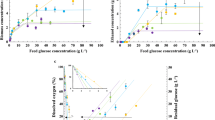Abstract
When cell-saturating amounts of glucose and phosphate were added to steady state cultures ofKlebsiella aerogenes that were, respectively, glucose-and phosphate-limited, the organisms responded immediately with an increased oxygen consumption rate. This suggested that in neither case was glucose transport the rate-limiting process, and also that organisms must posses effective mechanisms for spilling the excess energy initially generated when a growth-limitation is temporarily relieved.
Steady state cultures of mannitol- or glucose-limited organisms also seemingly generated energy at a greater rate than was required for cell synthesis since gluconate-limited cultures consumed oxygen at a lower rate, at each corresponding growth rate, than did mannitol- or glucose-limited cultures, and there-fore expressed a higherY o value. Thus, mannitol- and glucose-limitations must be essentially carbon (and not energy) limitations. The excess energy generated by glucose metabolism is one component of “maintenance” and could be used at lower growth rates to maintain an increased solute gradient across the cell membrane, imposed by the addition of 2%, w/v, NaCl to the growth environment.
The maintenance rates of oxygen consumption ofK. aerogenes also could be caused to increase by adding glucose discontinuously (drop-wise) to a glucose-limited chemostat culture, or by exchanging nitrate for ammonia as the sole utilizable nitrogen source.
The significance of these findings to an assessment of the physiological factors circumscribing energy-spilling reactions in aerobic cultures ofK. aerogenes is discussed.
Similar content being viewed by others
References
Belaich, J. P., Belaich, A., Simonpietri, P.: Uncoupling in bacterial growth: Effect of pantothenate starvation on growth ofZymomonas mobilis. J. gen. Microbiol.70, 179–185 (1972)
Brooks, J. D., Meers, J. L.: The effect of discontinuous methanol addition on the growth of a carbon-limited culture ofPseudomonas. J. gen. Microbiol.77, 513–519 (1973)
Brown, C. M., Macdonald-Brown, D. S., Meers, J. L.: Physiological aspects of microbial inorganic nitrogen metabolism. Advanc. Microbial Physiol.11, 1–52 (1974)
Dawes, E. A., McGill, D. J., Midgley, M.: Analysis of fermentation products. In: Methods in microbiology, Vol. 6A (J. R. Norris, D. W. Ribbons, eds.), pp. 53–216. London-New York: Academic Press 1971
Downs, A. J., Jones, C. W.: Energy conservation inBacillus megaterium. Arch. Microbiol.105, 159–167 (1975)
Evans, C. G. T., Herbert, D., Tempest, D. W.: The continuous cultivation of micro-organisms. 2. Construction of a chemostat. In: Methods in microbiology, Vol. 2 (J. R. Norris, D. W. Ribbons, eds.), pp. 277–327. London-New York: Academic Press 1970
Gunsalus, I. C., Shuster, C. W.: Energy-yielding metabolism in bacteria. In: The bacteria, Vol. II: Metabolism (I. C. Gunsalus, R. Y. Stanier, eds.), pp. 1–58. New York-London: Academic Press 1961
Harrison, D. E. F., Loveless, J. E.: Transient responses of facultatively anaerobic bacteria growing in chemostat culture to a change from anaerobic to aerobic conditions. J. gen. Microbiol.68, 45–52 (1971)
Hempfling, W. P., Mainzer, S. E.: Effects of varying the carbon source limiting growth on yield and maintenance characteristics ofEscherichia coli in continuous culture. J. Bact.123, 1076–1087 (1975)
Herbert, D., Kornberg, H. L.: Glucose transport as rate-limiting step in the growth ofEscherichia coli on glucose. Biochem. J.156, 477–480 (1976)
Koch, A. L.: The adaptive responses ofEscherichia coli to a feast and famine existence. Advanc. Microbiol Physiol.6, 147–218 (1971)
Le Gall, J., Senez, J. C.: Influence de la fixation de l'azote sur la croissance deDesulfovibrio desulfuricans. C.R. Acad. Sci. (Paris)250, 404–406 (1960)
Luscombe, B. M.: The effect of dropwise addition of medium on the yield of carbon limited cultures ofArthrobacter globiformis. J. gen. Microbiol.83, 197–198 (1974)
Mainzer, S. E., Hempfling, W. P.: Effects of growth temperature on yield and maintenance during glucose-limited continuous culture ofEscherichia coli. J. Bact.126, 251–256 (1976)
Neijssel, O. M., Tempest, D. W.: The regulation of carbohydrate metabolism inKlebsiella aerogenes NCTC 418 organisms, growing in chemostat culture. Arch. Microbiol.106, 251–258 (1975)
Neijssel, O. M., Tempest, D. W.: Bioenergetic aspects of aerobic growth ofKlebsiella aerogenes NCTC 418 in carbon-limited and carbon-sufficient chemostat culture. Arch. Microbiol.107, 215–221 (1976)
Pichinoty, F.: Reduction assimilative du nitrate par les cultures aérobies d'Aerobacter aerogenes. Influence de la nutrition azotée sur la croissance. Folia microbiol. (Praha)5, 165–170 (1960)
Pirt, S. J.: The maintenance energy of bacteria in growing cultures. Proc. roy. Soc. B163, 224–231 (1965)
Rogers, P. J., Stewart, P. R.: Energetic efficiency and maintenance energy characteristics ofSaccharomyces cerevisiae (wild type and petite) andCandida parapsilosis grown aerobically and micro-aerobically in continuous culture. Arch. Microbiol.99, 25–46 (1974)
Rosenberger, R. F., Elsden, S. R.: The yields ofStreptococcus faecalis grown in continuous culture. J. gen. Microbiol.22, 726–739 (1960)
Senez, J.: Some considerations of the energetics of bacterial growth. Bact. Rev.26, 95–107 (1962)
Stouthamer, A. H., Bettenhaussen, C.: Utilization of energy for growth and maintenance in continuous and batch culture of microorganisms. A reevaluation of the method for the determination of ATP production by measuring molar growth yields. Biochim. biophys. Acta (Amst.)301, 53–70 (1973)
Stouthamer, A. H., Bettenhaussen, C.: Determination of the efficiency of oxidative phosphorylation in continuous cultures ofAerobacter aerogenes. Arch. Microbiol.102, 187–192 (1975)
Tempest, D. W., Meers, J. L., Brown, C. M.: Influence of environment on the content and composition of microbial free amino acid pools. J. gen. Microbiol.64, 171–185 (1970)
Tempest, D. W., Neijssel, O. M.: Microbial adaptation to low-nutrient environments. In: Proc. 6th Int. Symp. Continuous Culture of Micro-organisms. London: Society of Chemical Industry 1976 (in press)
van Verseveld, H. W., Stouthamer, A. H.: Oxidative phosphorylation inMicrococcus denitrificans. Calculation of the P/O ratio in growing cells. Arch. Microbiol.107, 241–247 (1976)
Watson, T. G.: Effects of sodium chloride on steady-state growth and metabolism ofSaccharomyces cerevisiae. J. gen. Microbiol.64, 91–99 (1970)
Author information
Authors and Affiliations
Rights and permissions
About this article
Cite this article
Neijssel, O.M., Tempest, D.W. The role of energy-spilling reactions in the growth ofKlebsiella aerogenes NCTC 418 in aerobic chemostat culture. Arch. Microbiol. 110, 305–311 (1976). https://doi.org/10.1007/BF00690243
Received:
Issue Date:
DOI: https://doi.org/10.1007/BF00690243




